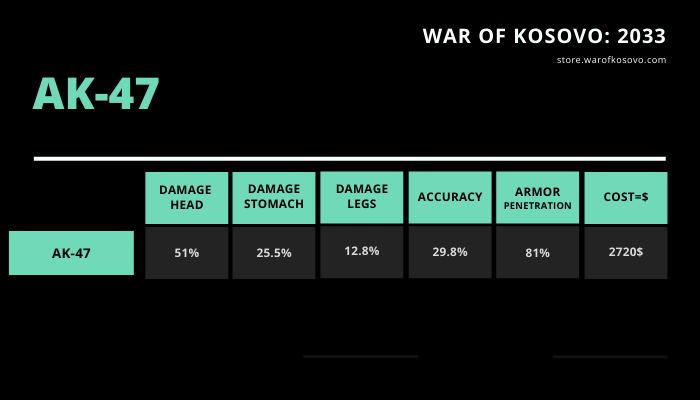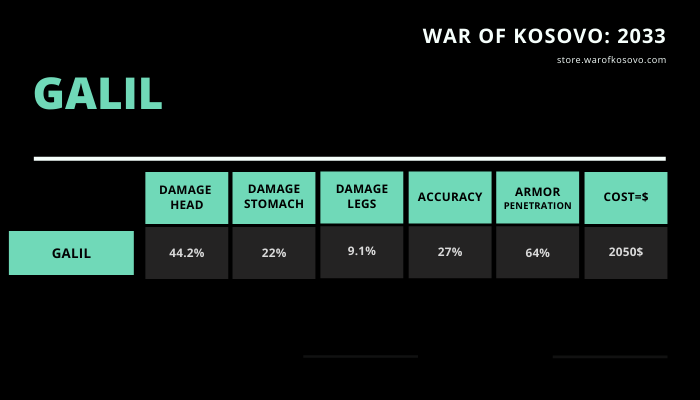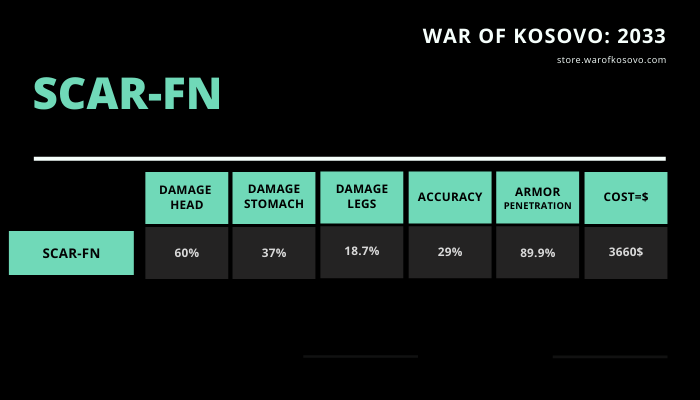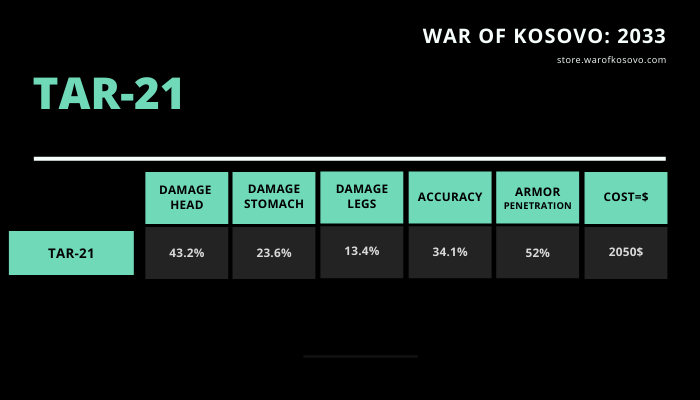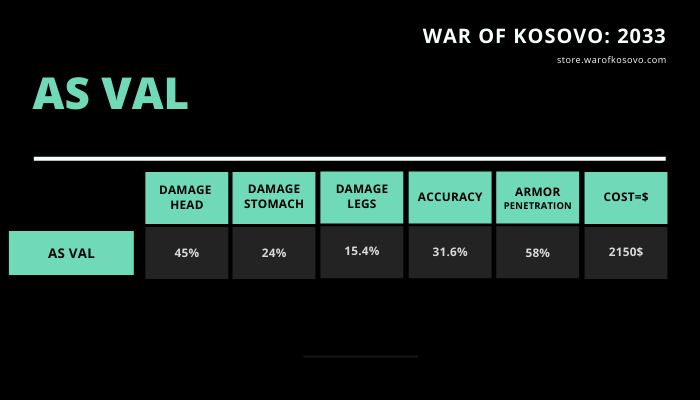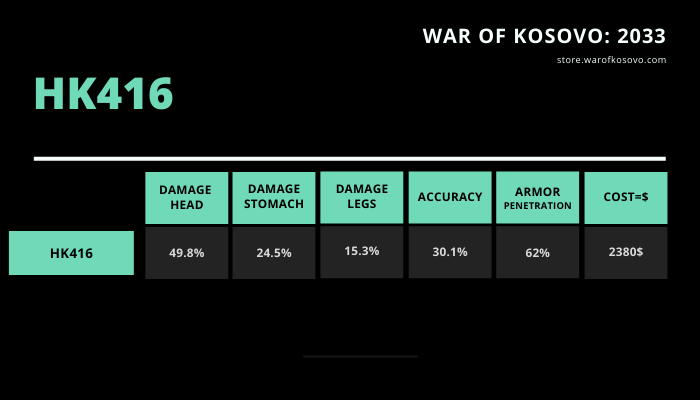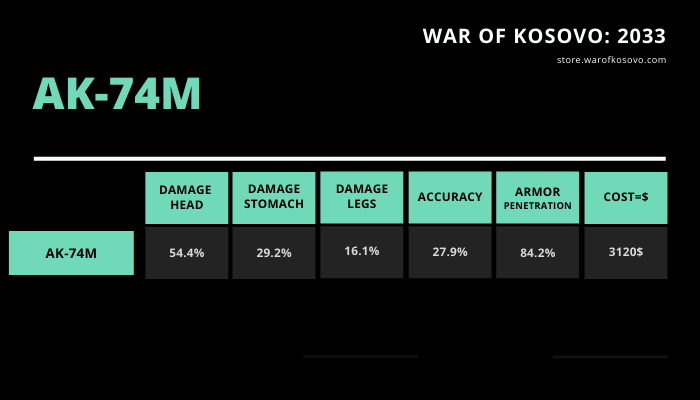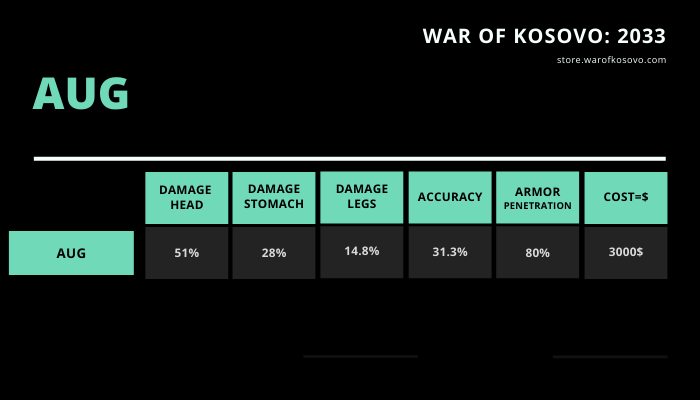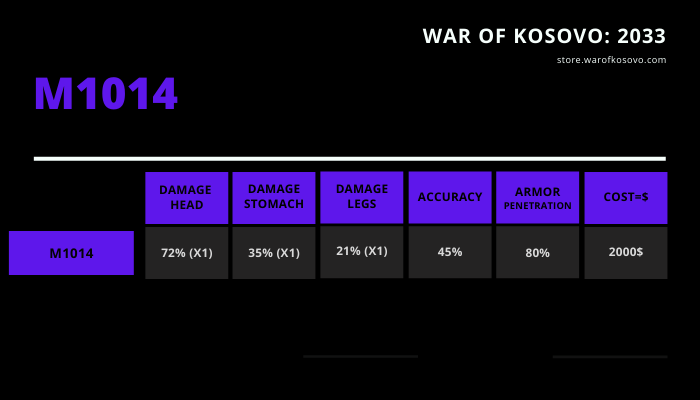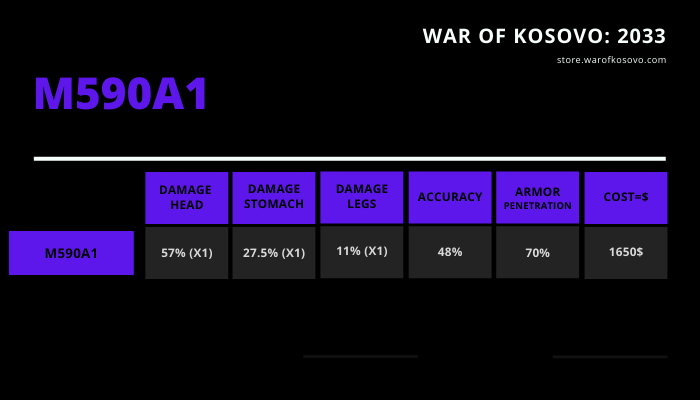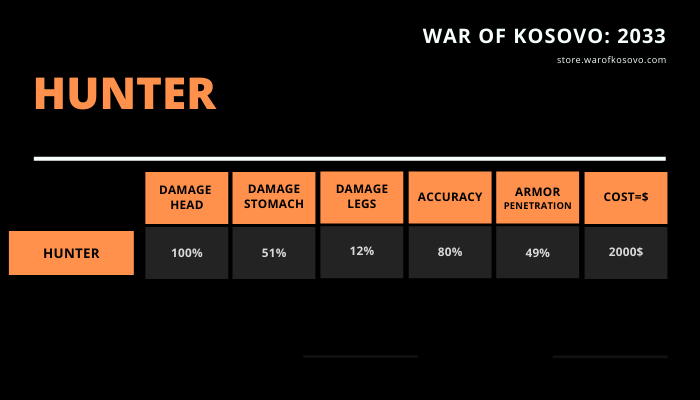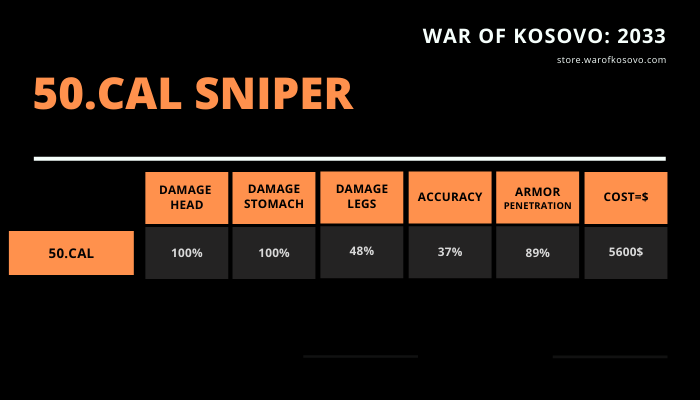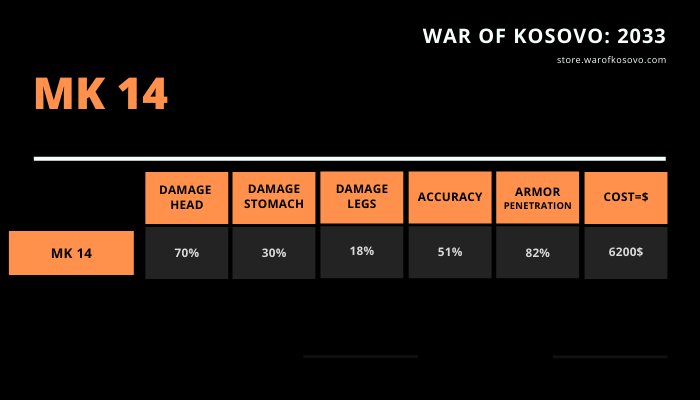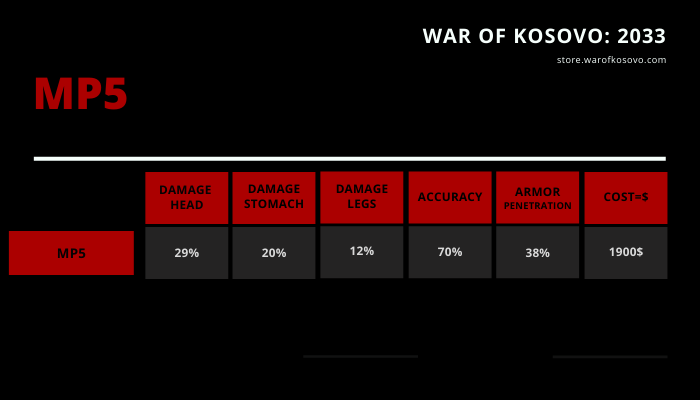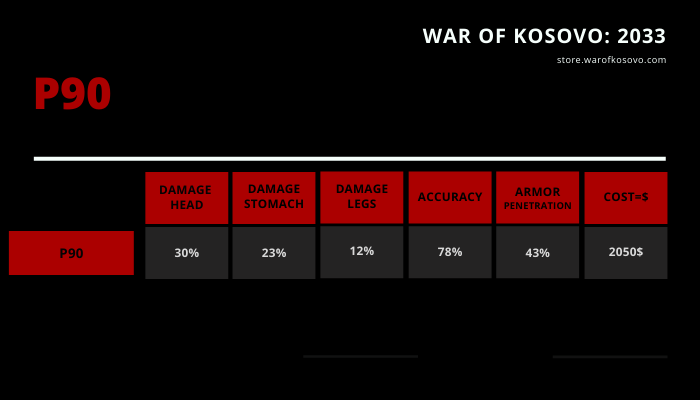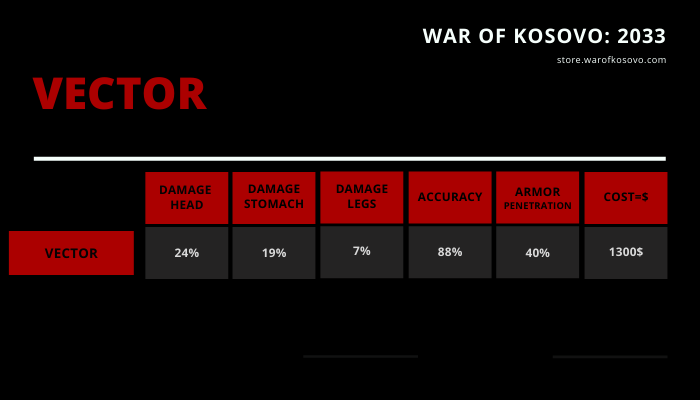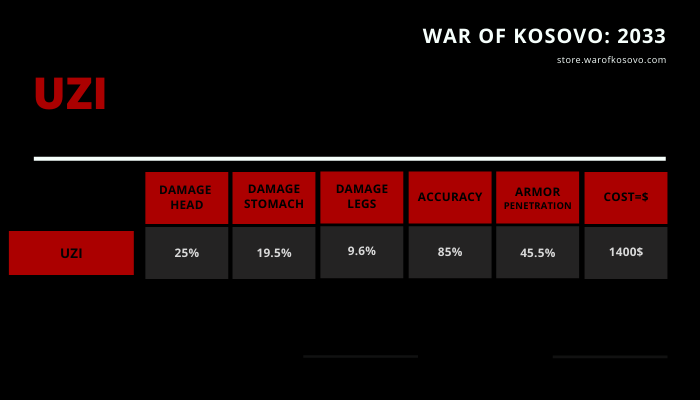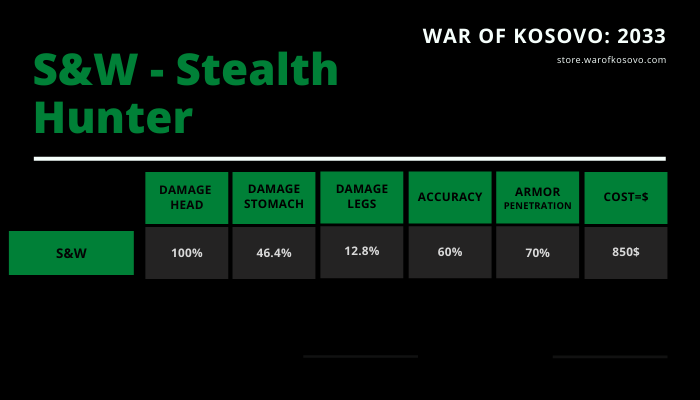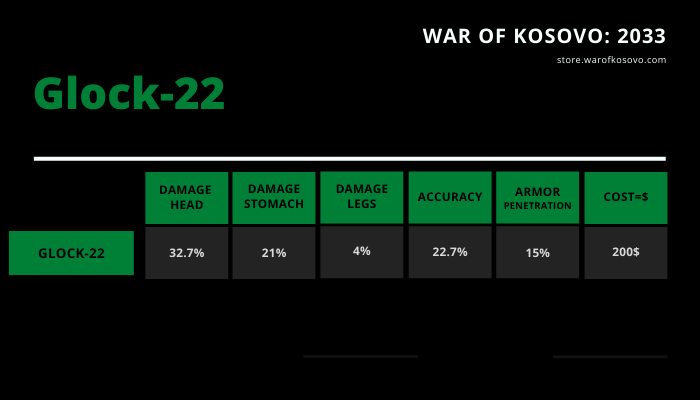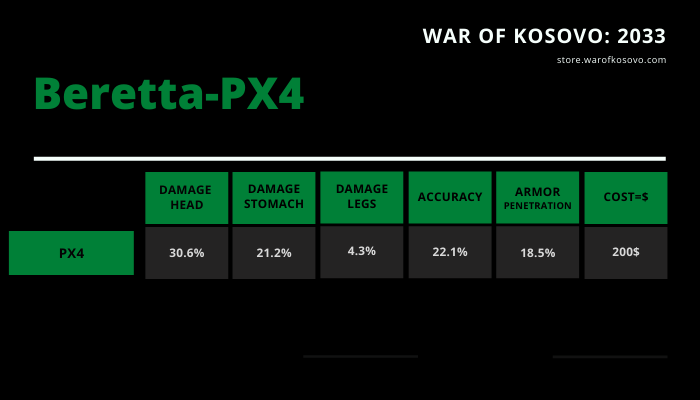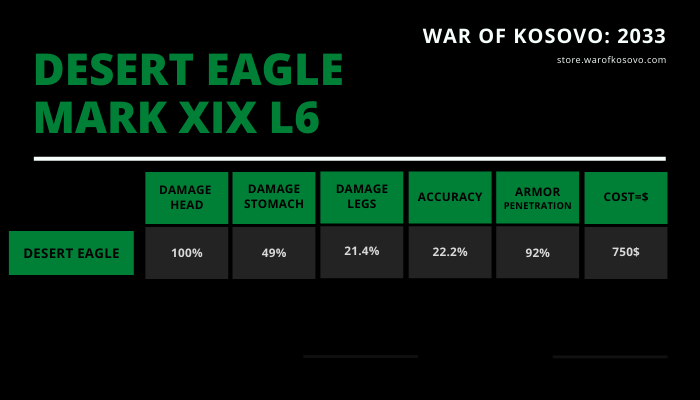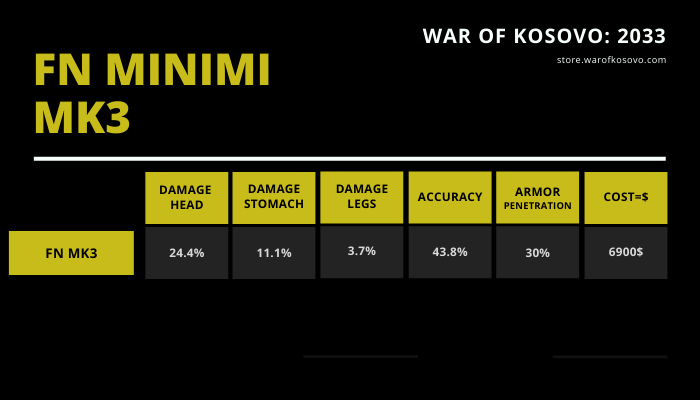There will be different weapons on each class. These weapons showed below are officially accepted and will be ready to be shown on players hands on the launch day. Modifications or adding/removing weapons can be made during the process of the game.
ASSAULT RIFLE
AK47
The AK-47, officially known as the Avtomat Kalashnikova (Russian: Автома́т Кала́шникова, 'Kalashnikov's assault rifle also known as the Kalashnikov or just AK), is a gas-operated, 7.62×39mm assault rifle developed in the Soviet Union by Mikhail Kalashnikov in the aftermath of World War II. It is the originating firearm of the Kalashnikov rifle (or "AK") family. The number 47 refers to the year it was finished.
GALIL
The Galil is fed from a curved, steel box magazine with a 35-rounds and capacity (SAR and AR versions), a 50-round capacity (ARM model) or a special color-coded 12-round magazine blocked for use exclusively with ballistite (blank) cartridges, used to launch rifle grenades. The magazine is inserted front end first in a similar manner to the AK family.
AR15
While most earlier breech-loading rifles had a single receiver housing both the trigger and reloading mechanism, an innovative feature of the AR-15 was modular construction to simplify substitution of parts and avoid need for arsenal facilities for most repairs of malfunctioning military rifles.
SCAR-FN
The SCAR-FN fires the more powerful 7.62×51mm NATO from proprietary 20-round magazines. Different length barrels are available for close quarters battle and for longer-range engagements. The initial solicitation indicated that the SCAR-FN would also be able to be chambered in 7.62×39mm M43 Kalashnikov cartridge and 6.8×43mm Remington SPC cartridge.
TAR -21
The Tavor uses a bullpup configuration, in which the receiver, bolt carrier group and magazine are placed behind the pistol grip. This shortens the firearm's overall length without sacrificing barrel length. As a result, the Tavor provides carbine overall length, yet can achieve rifle muzzle velocities if equipped with a rifle-length barrel.
AS VAL
TheVal is integrally suppressed and chambered in 9×39mm, a subsonic cartridge, in order to reduce its report and was designed alongside the VSS Vintorez, a similar rifle designed for precision shooting. Four rows of nine holes are drilled in the barrel near which follow the rifling and allow gas to escape the barrel behind the projectile into the suppressor.
HK416
The HK416 uses a HK-proprietary short-stroke gas piston system that derives from the HK G36, forgoing the concentric to bore gas piston system standard in AR-15 rifles. The HK G36 gas system was in turn partially derived from the AR-18 assault rifle designed in 1963. The HK system uses a short-stroke piston driving an operating rod to force the bolt carrier to the rear. This design prevents combustion gases from entering the weapon's interior—a shortcoming with direct impingement systems.
AK 74M
The AK-74M was designed by А. D. Kryakushin's group under the design supervision of Mikhail Kalashnikov and is an adaptation of the 7.62×39mm AKM assault rifle and features several important design improvements These improvements were primarily the result of converting the rifle to the intermediate-calibre high velocity 5.45×39mm cartridge.
AUG
The Steyr AUG is a selective-fire, bullpup weapon with a conventional gas-piston-operated action that fires from a closed bolt. It is designed as a Modular Weapon System that could be quickly configured as a rifle, a carbine, a sniper rifle, a sub-machine gun and even an open-bolt squad automatic weapon.
AR556
he rifle features a "two-stage" piston mechanism as opposed to the semi-direct impingement system of the AR-15. Gas flow is controlled by a four position regulator. Several key parts, such as the short stroke gas piston, gas regulator, and bolt/carrier group are chrome plated.
SHOOTGUN
M1014
The M4 was the first gas-operated shotgun produced by Benelli. Its function is designed around an entirely new design called the "auto-regulating gas-operated" (ARGO) system. The short-stroke design uses two self-cleaning stainless steel pistons located just ahead of the chamber to function opposite a rotating bolt, thereby eliminating the need for the complex mechanisms found on other gas-actuated automatics.
M590A1
The action of the Shockwave is taken from M590A1 series of shotguns. It features the same sliding tang safety on the top rear of the receiver, twin action bars, and dual extractors seen on other models. The name is inherited from the manufacturer of the grip, Shockwave Technologies. Mossberg claims the grip reduces recoil.
Kel-Tec KSG
he Kel-Tec KSG is a bullpup 12-gauge pump-action shotgun. It has two tube magazines which the user of the gun can switch between manually. Each tube holds up to seven 2.75-inch (70 mm) 12-gauge shotshells or six 3-inch (76 mm) shotshells. Kel-Tec has also introduced a larger variant, called the KSG25, which holds 24+1 rounds to the originals 14+1 rounds
SNIPER
HUNTER
Leupold Ultra M3A 10×42mm fixed power, or Leupold Mk 4 LR/T M3 10×40mm fixed power scope. Detachable emergency Redfield-Palma International back-up iron sights, they are attached to iron sight bases that are screwed into drilled and tapped holes machined into the front of the barrel and back on the left side of the receiver.
50.CAL SNIPER
The .300 Winchester Magnum (7.62×67mm) cartridge was designed as a magnum hunting cartridge and offers a flatter trajectory and a significant increase in muzzle velocity, wind resistance and supersonic range over the dimensionally smaller 7.62×51mm NATO cartridge.
MK 14
This weapon upgrades the standard M14 action and replaces the standard 22.0-inch (560 mm) barrel with an 18.0-inch (460 mm) barrel bolted onto a telescoping chassis stock system with a pistol grip, a different front sight, Harris bipod, four Picatinny accessory rails (which surround the barrel), and a more effective flash hider in place of the standard lugged USGI flash suppressor.
SMG
MP5
The primary version of the MP5 family is the MP5A2, which is a lightweight, air-cooled, selective fire delayed blowback operated 9×19mm Parabellum weapon with a roller-delayed bolt. It fires from a closed bolt (bolt forward) position.
P90
The P90 is a selective fire, straight blowback-operated weapon with a cyclic rate of fire of around 850–1,100 rounds per minute. The weapon is chambered for FN's 5.7×28mm ammunition. Its unusual shape is based on extensive ergonomic research. The weapon is grasped by means of a thumbhole in the frame that acts as a pistol grip, as well as an oversized trigger guard that acts as a foregrip for the shooter's support hand.
VECTOR
The Vector uses an articulated mechanism referred to as the "Kriss Super V," which allows the bolt and an inertia block to move downward into a recess behind the magazine well. The theory is that at the end of this travel, the energy is transmitted downward rather than rearward, thus reducing the felt recoil.
UZI
The open bolt design exposes the breech end of the barrel, and improves cooling during periods of continuous fire. However, it means that since the bolt is held to the rear when cocked, the receiver is more susceptible to contamination from sand and dirt. It uses a telescoping bolt design, in which the bolt wraps around the breech end of the barrel.
Pistols
S&W - Stealth Hunter
S&W produced large numbers of the Model 3, in three distinct models, for the Russian Empire by special order. The first was the 1st Model Russian (the original order design), with the Russian Ordnance Inspector mandating a number of improvements to the design, resulting in the 2nd Model Russian, with a final revision to the Russian design being known as the 3rd Model Russian
Glock 22
The Glock 17 is a 9 mm short recoil–operated, locked-breech semi-automatic pistol that uses a modified Browning cam-lock system adapted from the Hi-Power pistol. The firearm's locking mechanism uses a linkless, vertically tilting barrel with a rectangular breech that locks into the ejection port cut-out in the slide. During the recoil stroke, the barrel moves rearward initially locked together with the slide about 3 mm (0.12 in) until the bullet leaves the barrel and chamber pressure drops to a safe level.
Beretta PX4
Unlike the later generation Beretta 92/96/M9 series, the Px4's trigger guard is rounded for better concealed carry. The takedown pin of earlier models is replaced by a spring-loaded bar, accessed via frame recesses on both sides, which must be grasped and pulled down simultaneously to release the slide.
Desert Eagle Mark XIX L6
The design for the Desert Eagle was initiated by Bernard C. White of Magnum Research and Arnolds Streinbergs of Riga Arms Institute, who filed a US patent application for a mechanism for a gas-actuated pistol in January 1983. This established the basic layout of the Desert Eagle. A second patent application was filed in December 1985, after the basic design had been refined by IMI Systems (Israel Military Industries) for production, and this is the form that went into production.
The pistol is fired by a single action hammer, and has a manual safety switch on the slide. The ambidextrous safety switch rotates a drum mechanism which sits over the firing pin, causing the firing pin to lock in, which prevents it from moving forward and reduces the possibility of the gun discharging accidentally. With the safety off, pulling the trigger releases the hammer to fall downward, hitting the firing pin and causing the chambered round to discharge.
Machine Guns
FN Minimi Mk3
The Minimi uses a gas-actuated long-stroke piston system. The barrel is locked with a rotary bolt, equipped with two massive locking lugs, forced into battery by a helical camming guide in the bolt carrier. Upon firing, the piston is forced to the rear by expanding propellant gases bled through a port in the barrel near the muzzle end. The piston rod acts against the bolt carrier, which begins its rearward motion guided on two rails welded to the receiver walls, while the bolt itself remains locked.

